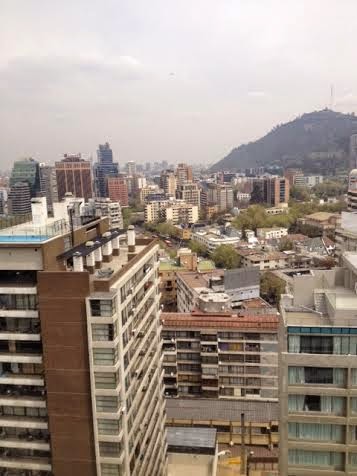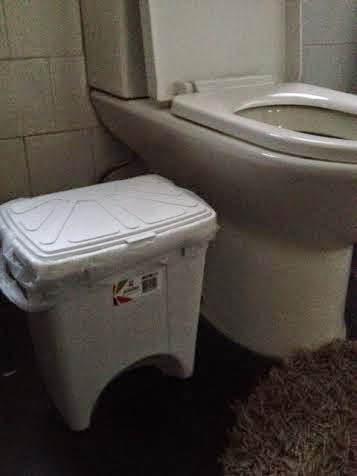The view from my new office!
In this post I wanted to share some of the small differences I've noted as a foreigner living in Chile. For the most part, if I'm being completely honest, Santiago is not that different from major US cities, at least in the big picture. It just doesn't feel that different from other major cities I've been to.
Day-to-day things ("lo cotidiano" in Spanish) are somewhat different, though.
We'll start with the grocery store.
I love grocery shopping. It's always been one of my favorite pasttimes. I like to eat and I like to cook, so the grocery store has always provided both inspiration and relaxation for me. I eat a lot of fruits and vegetables, so I spend a lot of time in the produce section. In the produce section in US grocery stores, you bag your fruits and vegetables, and plop them in your cart. When you get to the register, the cashier weighs it on their little scale, and the charge gets added to your total. Easy peasy.
In Chile, there's a produce weigher (or weighers in bigger stores) in the produce section of every grocery store. You bag your items, and before leaving that section of the store, you get them weighed. That way, you know exactly how much your fruits and vegetables are going to cost before you go to pay. For that reason, it's helpful. However, the line to weigh can get long, and if you forget to weigh your fruits and vegetables before you get to checkout, the checkout cashier will have you go back to the produce section to weigh them, as they don't have a scale on their register.
I tried to take a stealthy photo. The woman in pink is handing her bagged bananas to the produce weigher, who is standing behind the woman in black.
Another difference in the grocery store is that you tip your baggers. Most of the baggers are college students, and a lot of them actually pay the grocery store a small fee in order to work there. They pay a little to the store in hopes of making a lot from the customers' tips. I usually tip between 500 and 1000 pesos, which is between $0.83 and $1.67.
I felt weird taking pictures of the baggers. Here is a snapshot of two baggers standing outside the grocery store. They wear similar uniforms, and they're at every register.
Now let's talk about the differences in the home.
One of the biggest ones is that you can't throw the toilet paper in the toilet. (Well, there are some fancy new toilets and buildings with fancy new pipes that allow you to flush the paper, but in general, the pipes in Santiago are old, and people refrain from disposing of the paper in the toilet.) Instead, you put the used toilet paper in a trash can by the toilet. It's perfectly fine, and you get used to it. Most bathroom trashcans have lids on them, but even if they don't, it doesn't make the bathroom smell bad, surprisingly.
A very exciting picture of our toilet and trash can.
Luckily, no one is accumulating large quantities of bathroom trash, because the trash collectors come every day. Most people only have small trashcans in their kitchens and bathrooms, and they use grocery bags as trash bags. You have a window of time between 7pm and 11pm to put out your trash. (That way, the trash doesn't sit out all day during the day, but you still have time to put it out.) The collectors seem to visit my street around midnight. This is very convenient for apartments, especially older apartments like mine, where there's no dumpster to take your trash.
Another thing about disposal - you take you recyclables to recycling areas. There's a glass bottle dropoff at the metro station by my house, and there's a plastics recycling area a few mentro stops in the other direction. I find that we don't really consume a lot of plastic or glass, but when we do, Matt takes it to the recycling centers. (Thanks, Matt!)
One last difference about home life: coffee. Now, I don't drink coffee, so this is just observational, but from what I've seen, coffee machines are not that popular here. Most people use a French press and an electric kettle. I've heard that French pressed coffee (and loose tea) is quite good, but to me, it seems a bit inconvenient. Of course, you could always go to Starbucks (which is popular here).
The French press my roommates use.
What about the differences while you're out and about?
First, at the office, you only get paid once a month (at the end of the month). In the US, most businesses even cut paychecks twice a month (some jobs even pay once a week), but in Chile, the standard is once a month. I've heard this makes budgeting easier on most people. You have to make your money stretch a little further, so it makes you check your balance more frequently, and makes you more conscious of what you're buying.
Another thing I've noticed is that phones don't "ring" here. When you make a call to a Chilean phone (cell phone or land line), the phone on the other end doesn't ring like it does in the US; instead it makes a low-toned beep sound. Actually it's more like a "boop" sound. When I call Matt's Chilean phone, while I'm waiting for him to pick up, I hear: booooooooooop, booooooooooop.
My high tech Chilean cell phone.
One last thing with phones: area codes are different. In Santiago, if you want to call a land line number, dial 02 then the number. To call a cell phone, dial 09 then the number.
I've mentioned before that Sundays are quite quiet here in Santiago. On Sunday, most everything is closed. The only places that stay open are churches, pharmacies, gyms, and grocery stores. Surprisingly, restaurants close on Sundays, and sometimes on Saturdays, too. Even Starbucks in closed on Sundays! In the US, that would be unheard of, as many people like to go out to eat or go for coffee on Sundays.
One last difference I've noted (or at least the last I can remember for now) is that in some stores (department stores for the most part), you get two receipts. For example, when I buy makeup in the department store, or when I buy envelopes from the office supply store, I take my purchases to the counter when they ring me up and give me a small ticket style receipt. The ticket has a number code on it. That cashier holds my items behind the counter. Next, I go to the actual cashier (with receipt in hand, but carrying no items). The cashier takes my ticket, enters the number, and can then ring me out so I can pay. I have no idea how this process can be seen as efficient or necessary. It's very confusing to me, and it seems like a waste of time on the customer's end, and a waste of money on the business' end. Why pay for a separate cashier for a role that seems superfluous? This is the one inconvenient difference I've noticed between Chile and the US.
I'm sure I'm forgetting some things, so I might do another post like this in the future. But for now, for those who were asking how Chile is different from the US, here you are!






This comment has been removed by the author.
ReplyDeleteHi Ms. Grant! I can't believe you've been in Chile since July! Time really flies by. :) The weighing station in the produce section of the grocery store is an interesting concept... It definitely would make the checkout lines go faster, which is something I wish would happen at my grocery store! :)
ReplyDelete